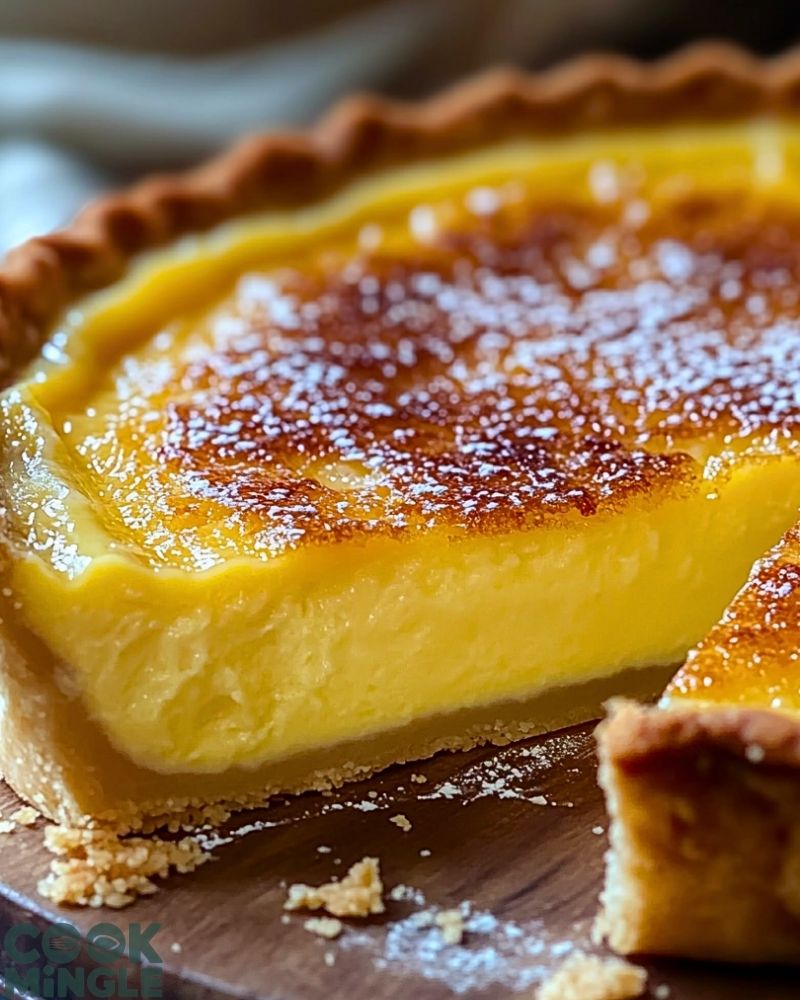There’s something deeply nostalgic about a slice of egg custard pie. Maybe it’s the silky texture, the simple yet comforting flavor, or the golden sheen on top that makes you feel like you’re home. I grew up watching my grandmother whisk eggs and sugar together with such precision, and I was always fascinated by how a few humble ingredients transformed into something so elegant. Today, I’ve taken her traditional egg custard pie and given it a simpler, more approachable twist—something that doesn’t require a special occasion to enjoy.

This version is all about creamy ease. No complicated steps or elusive ingredients—just a smooth, lightly sweetened custard nestled in a buttery, flaky crust. It’s a dessert that’s as satisfying to make as it is to eat. And the best part? It works just as well for a cozy Sunday lunch as it does for a formal dinner party. Let’s dive into what makes this pie so special.
Why You’ll Love This Egg Custard Pie
- Velvety Texture: The custard bakes into a luxuriously smooth consistency that practically melts on your tongue.
- Simple Ingredients: Eggs, sugar, milk, vanilla, and a pie crust—that’s it. Nothing fancy, just pantry staples.
- Foolproof Method: With just a bit of whisking and baking, you’ll have a bakery-worthy pie without any stress.
- Old-Fashioned Charm: This recipe brings a lovely retro vibe to the table, reminiscent of diners and grandma’s kitchen.
- Versatile Delight: Serve it chilled or warm, plain or topped with berries or a dusting of nutmeg.
What Kind of Crust Should I Use for Egg Custard Pie?
When it comes to the crust, I prefer a classic buttery pie crust—either homemade or store-bought. A traditional shortcrust pastry holds up beautifully against the silky custard and adds a bit of richness and texture. If you’re short on time, a quality frozen or refrigerated pie crust will do just fine—just make sure to blind-bake it first to avoid a soggy bottom.
For those looking to experiment, you could try a graham cracker crust for a sweeter, crunchier contrast, though it’s less traditional. I’ve also seen versions with puff pastry for a slightly fancier finish. Whatever you choose, the key is a crisp base that complements the creamy filling without overpowering it.
Options for Substitutions
One of the best things about this pie is its adaptability. Here are a few smart swaps if you need them:
- Dairy-Free: Use full-fat coconut milk or a blend of almond and oat milk. The result won’t be quite as rich, but it will still be smooth and flavorful.
- Sugar Alternatives: You can replace granulated sugar with coconut sugar, honey (reduce the quantity slightly), or a sugar substitute like erythritol for a lower-carb version.
- Egg-Free: While tricky in a custard recipe, you can experiment with silken tofu or agar-agar for a vegan version, though the texture will change significantly.
- Crustless: If you’re going gluten-free or just want something lighter, you can skip the crust entirely and bake it in ramekins for a flan-like dessert.
- Add-ins: A pinch of cinnamon or nutmeg, a splash of rum, or lemon zest can elevate the flavor without compromising the custard’s character.
Ingredients for This Egg Custard Pie
Each ingredient in this pie has a purpose, and together they create a harmony of texture and flavor that’s hard to beat.
- Eggs
The backbone of any custard. Eggs thicken the mixture and give the pie its signature structure and silky texture. - Granulated Sugar
Just the right amount of sweetness to balance the richness of the eggs and milk. It also helps achieve that beautiful caramelized top. - Whole Milk
For the creamiest custard, whole milk is essential. It provides fat and liquid without making the pie too heavy. You could also mix in a bit of cream for extra richness. - Vanilla Extract
Adds a warm, aromatic layer of flavor that rounds out the custard beautifully. - Salt
Just a pinch enhances all the other ingredients and brings balance to the sweetness. - Nutmeg (optional but recommended)
A classic topping for egg custard pies—grated over the top before baking, it gives a subtle spice and traditional touch. - Pie Crust (homemade or store-bought)
This is the vessel that holds your custard. It should be blind-baked before pouring in the filling to ensure it stays crisp and flaky.

Step 1: Preheat and Prepare Your Crust
Start by preheating your oven to 375°F (190°C). If you’re using a store-bought crust, roll it out into a 9-inch pie dish and crimp the edges if desired. Prick the bottom with a fork to prevent puffing and blind-bake it with pie weights or dried beans for about 10–12 minutes, until lightly golden. Remove from the oven and let it cool slightly.
Step 2: Whisk the Custard Mixture
In a large mixing bowl, whisk together 4 large eggs until they’re well blended. Gradually add in ¾ cup of granulated sugar and continue whisking until the mixture is pale and smooth. This step ensures your custard will be lump-free and silky.
Step 3: Add the Milk and Flavoring
Slowly pour in 2½ cups of whole milk while continuing to whisk. Add 1½ teaspoons of pure vanilla extract and a small pinch of salt. If you’re using nutmeg, now’s a good time to stir in ¼ teaspoon or save it to grate over the top.
Step 4: Pour and Set
Carefully pour the custard mixture into your pre-baked pie crust. Don’t overfill—leave a little room at the top to prevent overflow while baking. If you’re nervous about spills, place the pie pan on a baking sheet before transferring it to the oven.
Step 5: Bake Gently
Bake the pie at 350°F (175°C) for 45 to 55 minutes. The edges should be set, but the center should still have a gentle jiggle when you nudge the pan. This ensures a creamy—not rubbery—texture once cooled.
Step 6: Cool and Chill
Remove the pie from the oven and let it cool at room temperature for at least an hour. For best results, refrigerate it for another 2–3 hours to fully set the custard. Dust with powdered sugar or fresh grated nutmeg before serving, if you like.
How Long to Cook the Egg Custard Pie
The baking time for this pie generally ranges from 45 to 55 minutes at 350°F (175°C). Your oven may vary, so begin checking around the 45-minute mark. The pie is done when the edges are firm but the center still has a slight wobble—this is key for that creamy, custardy texture.
After baking, let it cool on the counter for at least an hour, then refrigerate for 2 to 3 hours to fully set before slicing. It’s worth the wait, I promise.
Tips for Perfect Egg Custard Pie
- Blind-Bake the Crust: Always pre-bake your crust to avoid a soggy bottom. It makes a world of difference in texture.
- Strain the Custard (Optional): If you want an ultra-smooth filling, strain the mixture through a fine mesh sieve before pouring it into the crust.
- Don’t Overbake: Watch closely toward the end. Overbaking leads to curdled, rubbery custard. A little jiggle in the center is ideal.
- Cool Gradually: Avoid sudden temperature changes, which can cause cracks. Let it cool on the counter before refrigerating.
- Use Room Temperature Ingredients: Eggs and milk blend more smoothly when they’re not straight from the fridge.
- Nutmeg = Nostalgia: A sprinkle of freshly grated nutmeg on top is the classic finish. Adds a gentle warmth and that old-school charm.
- Slice with a Warm Knife: For neat slices, dip your knife in warm water and wipe between cuts.
Watch Out for These Mistakes While Cooking
Even with a simple dessert like this, a few missteps can impact the final result. Keep these in mind:
- Skipping the Blind Bake: If you don’t pre-bake your crust, you’ll likely end up with a soggy bottom. Custard fillings are wet and need a crisp base to sit on.
- Overmixing the Custard: Whisk gently to combine the ingredients. Over-whisking incorporates air, which can cause the custard to puff too much and crack.
- High Oven Temperature: Baking at too high a temp will cook the eggs too quickly and result in a curdled texture. Stick to 350°F (175°C).
- Overbaking: The number one custard sin. Once it’s fully firm in the center, it’s gone too far. Always check for that signature jiggle.
- Cutting Before It’s Set: Let it chill for at least a few hours. Cutting too soon will cause the custard to run and collapse.
- Improper Cooling: Placing it in the fridge too soon while still hot can lead to condensation or even cracking on top.
What to Serve With Egg Custard Pie?
This pie is a mellow, smooth dessert that plays well with a variety of flavors and textures. Here are some delicious accompaniments:
Fresh Berries
Blueberries, raspberries, or sliced strawberries add a burst of tartness that balances the sweet, creamy custard.
Whipped Cream
A dollop of lightly sweetened whipped cream makes every bite feel extra indulgent.
Caramel Drizzle
Drizzle a bit of warm caramel sauce over each slice for an irresistible layer of flavor.
Stewed Apples or Pears
Soft, spiced fruits add a cozy, autumnal twist—perfect for cooler months.
A Scoop of Ice Cream
Vanilla or cinnamon ice cream contrasts beautifully with the chilled custard.
Crushed Biscotti or Cookies
A little crunch on the side—or even crumbled on top—adds great textural contrast.
Black Tea or Strong Coffee
The mild custard pairs perfectly with something bold and slightly bitter to sip on.
Lemon Zest
A light dusting of lemon zest on top right before serving brightens up the flavor with a citrus spark.
Storage Instructions
Egg custard pie is best enjoyed within a few days, but if stored properly, it keeps its flavor and texture beautifully.
- Refrigeration: Always store the pie in the fridge. Cover it loosely with plastic wrap or foil once fully cooled. It will stay fresh for up to 4 days.
- Freezing: While custard pies don’t freeze as well as fruit or cream pies due to the delicate texture, you can freeze slices individually. Wrap each slice tightly in plastic wrap and then foil. Freeze for up to 1 month. Thaw overnight in the refrigerator.
- Reheating: If you like your custard warm, reheat a slice in the microwave on low for 15–20 seconds. Avoid overheating, or the texture might change.
Just remember: never leave this pie out at room temperature for more than 2 hours—the dairy and eggs make it perishable.
Estimated Nutrition
Here’s a rough nutritional estimate for one slice of egg custard pie (assuming 8 slices total):
- Calories: 290
- Total Fat: 15g
- Saturated Fat: 6g
- Cholesterol: 130mg
- Sodium: 200mg
- Total Carbohydrates: 30g
- Sugars: 21g
- Protein: 7g
- Fiber: <1g
These values will vary depending on the specific crust and milk you use, but this gives a solid baseline for planning.
Frequently Asked Questions
What’s the difference between custard pie and egg pie?
Egg pie is a Filipino dessert that includes a touch of condensed milk and often has a caramelized top, while classic custard pie typically uses whole milk, sugar, and eggs, with a more even-toned top and subtle flavor.
Can I make this pie ahead of time?
Yes, and it’s actually better that way! You can make it a day in advance and store it in the refrigerator. This gives it plenty of time to chill and set properly.
Why is my custard pie watery in the center?
It may have been underbaked or cut too early before fully setting. Ensure it cools for at least an hour at room temperature and chills for 2–3 hours in the fridge before slicing.
Can I use skim or low-fat milk?
You can, but the texture won’t be as rich or creamy. Whole milk is ideal. If you must go lighter, use 2% milk but avoid fat-free.
Should I strain the custard before baking?
It’s optional, but straining ensures a super smooth consistency by removing any chalazae (stringy bits from the egg) or foam.
Can I add flavorings like lemon or orange zest?
Absolutely! A little zest adds brightness and depth to the flavor. Just don’t overdo it—start with ½ teaspoon.
What’s the best way to transport this pie?
Once fully chilled, cover the pie securely with foil or place it in a pie carrier. Keep it level and cold if you’re traveling, especially in warm weather.
How do I know when it’s done baking?
Give the pie a gentle shake—if the edges are set and the center still slightly jiggles, it’s ready. It will continue to set as it cools.
Conclusion
Creamy, simple, and steeped in tradition, this egg custard pie is proof that classic desserts never go out of style. Whether you’re craving a slice of comfort or want to impress guests with something homemade and elegant, this recipe delivers. It’s the kind of pie that invites seconds, sparks memories, and disappears fast from any table.
All that’s left? Print it out and keep it close—you’ll be coming back to this one.

Creamy & Easy Egg Custard Pie Recipe
- Total Time: 3 hours
- Yield: 8 slices
Description
A smooth and creamy classic, this egg custard pie blends the rich taste of eggs, milk, and vanilla in a buttery crust. It’s easy to make, comforting to eat, and perfect for everything from family gatherings to a quiet evening treat.
Ingredients
- 4 large eggs
- 3/4 cup granulated sugar
- 2 1/2 cups whole milk
- 1 1/2 teaspoons vanilla extract
- Pinch of salt
- 1 pie crust (homemade or store-bought), blind-baked
- 1/4 teaspoon ground nutmeg (optional)
Instructions
- Preheat your oven to 375°F (190°C).
- Roll out your pie crust into a 9-inch pie dish, prick the bottom with a fork, and blind-bake it for 10–12 minutes. Let cool slightly.
- In a mixing bowl, whisk the eggs until fully blended.
- Add the sugar and continue whisking until smooth and pale.
- Slowly add the milk, vanilla extract, and a pinch of salt. Whisk until fully combined.
- (Optional) Strain the mixture through a fine mesh sieve for a smoother texture.
- Pour the custard filling into the pre-baked crust.
- (Optional) Sprinkle nutmeg over the top.
- Bake at 350°F (175°C) for 45–55 minutes, or until edges are set and center jiggles slightly.
- Remove from oven and let cool at room temperature for 1 hour.
- Refrigerate for at least 2–3 hours before serving.
- Prep Time: 15 minutes
- Chill Time: 2 hours
- Cook Time: 45 minutes

